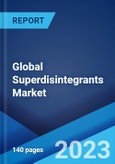The global superdisintegrants market size reached US$ 388.8 Million in 2022. Looking forward, the market is expected to reach US$ 590.1 Million by 2028, exhibiting a growth rate (CAGR) of 7.20% during 2022-2028.
Superdisintegrants are modified disintegrants added in drug formulations to facilitate the breakup or disintegration of tablets or capsules into smaller particles. They assist in increasing the absorption of the drug and the solubility of active pharmaceutical ingredients (APIs) in the body, thereby reducing the disintegration time or oral solid dosage forms and enhancing their efficiency. They are utilized at a low level in the solid dosage form, generally 1- 10% by weight relative to the total weight of the dosage unit. Presently, they are available in synthetic and natural variants and used in many therapeutic areas, such as cardiovascular, infectious, hematological, neurological, gastrointestinal diseases, and inflammatory diseases.
Superdisintegrants are modified disintegrants added in drug formulations to facilitate the breakup or disintegration of tablets or capsules into smaller particles. They assist in increasing the absorption of the drug and the solubility of active pharmaceutical ingredients (APIs) in the body, thereby reducing the disintegration time or oral solid dosage forms and enhancing their efficiency. They are utilized at a low level in the solid dosage form, generally 1- 10% by weight relative to the total weight of the dosage unit. Presently, they are available in synthetic and natural variants and used in many therapeutic areas, such as cardiovascular, infectious, hematological, neurological, gastrointestinal diseases, and inflammatory diseases.
Superdisintegrants Market Trends
Solid dosage medicines currently hold a significant share in the pharmaceutical industry. This, coupled with the rising number of people suffering from various age-related and chronic diseases, represents one of the key factors strengthening the growth of the market. Moreover, the extensive usage of superdisintegrants in the production of orally disintegrating tablets (ODTs) for antipsychotics, antidepressants, antimigraine, and sedatives is offering lucrative growth opportunities to industry investors. Apart from this, features like high compatibility, improved bioavailability, and efficient compressibility are catalyzing the demand for superdisintegrants worldwide. Additionally, leading players are considerably investing in product development and innovation of novel formulations to retain a competitive edge in the market. Besides this, stringent regulations are propelling the use of safer alternatives in the pharmaceutical industry, which is assisting in the wider acceptance of natural superdisintegrants around the world. Furthermore, the growing burden of neurological disorders, in confluence with the increasing popularity of telemedicine on account of the coronavirus disease (COVID-19) outbreak, is anticipated to impel the market growth.Key Market Segmentation
This research provides an analysis of the key trends in each sub-segment of the global superdisintegrants market report, along with forecasts at the global, regional and country level from 2023-2028. The report has categorized the market based on product, type, dosage form and therapeutic areas.Breakup by Product:
- Croscarmellose Sodium
- Crospovidone
- Sodium Starch Glycolate
- Ion Exchange Resin
- Modified Cellulose
Breakup by Type:
- Natural Superdisintegrant
- Synthetic Superdisintegrant
Breakup by Dosage Form:
- Tablets and Capsules
- Mouth-Dissolving Films
Breakup by Therapeutic Areas:
- Gastrointestinal
- Cardiovascular
- Neurology
- Oncology
- Hematology
Breakup by Region:
- North America
- United States
- Canada
- Asia-Pacific
- China
- Japan
- India
- South Korea
- Australia
- Indonesia
- Europe
- Germany
- France
- United Kingdom
- Italy
- Spain
- Russia
- Latin America
- Brazil
- Mexico
- Middle East and Africa
Competitive Landscape
The competitive landscape of the industry has also been examined along with the profiles of the key players being Asahi Kasei Corporation, Ashland Global Specialty Chemicals Inc., Avantor Inc., BASF SE, Corel Pharma Chem, DFE Pharma GmbH & Co. KG, DuPont de Nemours Inc., JRS Pharma GmbH & Co. KG, Merck KGaA, Nippon Soda Co. Ltd., Roquette Frères and Sigachi Industries Limited.Key Questions Answered in This Report:
- How has the global superdisintegrants market performed so far and how will it perform in the coming years?
- What has been the impact of COVID-19 on the global superdisintegrants market?
- What are the key regional markets?
- What is the breakup of the market based on the product?
- What is the breakup of the market based on the type?
- What is the breakup of the market based on the dosage form?
- What is the breakup of the market based on the therapeutic areas?
- What are the various stages in the value chain of the industry?
- What are the key driving factors and challenges in the industry?
- What is the structure of the global superdisintegrants market and who are the key players?
- What is the degree of competition in the industry?
Table of Contents
1 Preface3 Executive Summary12 Value Chain Analysis14 Price Analysis
2 Scope and Methodology
4 Introduction
5 Global Superdisintegrants Market
6 Market Breakup by Product
7 Market Breakup by Type
8 Market Breakup by Dosage Form
9 Market Breakup by Therapeutic Areas
10 Market Breakup by Region
11 SWOT Analysis
13 Porters Five Forces Analysis
15 Competitive Landscape
Companies Mentioned
- Asahi Kasei Corporation
- Ashland Global Specialty Chemicals Inc.
- Avantor Inc.
- BASF SE
- Corel Pharma Chem
- DFE Pharma GmbH & Co. KG
- DuPont de Nemours Inc.
- JRS Pharma GmbH & Co. KG
- Merck KGaA
- Nippon Soda Co. Ltd.
- Roquette Frères
- Sigachi Industries Limited
Methodology

LOADING...
Table Information
| Report Attribute | Details |
|---|---|
| No. of Pages | 140 |
| Published | November 2023 |
| Forecast Period | 2022 - 2028 |
| Estimated Market Value ( USD | $ 388.8 Million |
| Forecasted Market Value ( USD | $ 590.1 Million |
| Compound Annual Growth Rate | 7.2% |
| Regions Covered | Global |
| No. of Companies Mentioned | 12 |









